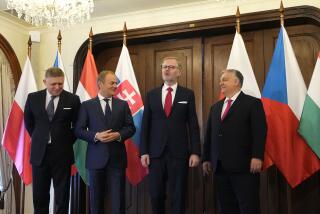Divorce Amicable as Czechs, Slovaks Forge Own Paths
SIDONIE, Czech Republic — Six miles east through woods and wildflowers lies a castle ruin that was long a favorite destination of scouts who summered at the Pohoda youth camp in the foothills of the White Carpathians.
But a consequence of Czechoslovakia’s “Velvet Revolution” against communism 10 years ago is that the young trekkers can’t go there anymore. The crumbled castle is now in a foreign country.
“All the best trails are on the Slovak side, but we don’t want to burden the children with getting passports so they can cross the border,” says camp director Lubomir Jenys. “We want the experience to be relaxing for them, and there is something rather stressful about having to carry documents into the woods.”
Barely three years after toppling one of Eastern Europe’s most inflexible Communist regimes, Czechs and Slovaks split their federation into two sovereign countries, recovering their separate national identities.
The experiment of uniting the small former parts of the Hapsburg Empire, which ruled Central Europe for centuries, failed after 75 years in part because it was never a marriage of equals. Czechs were more numerous and more prosperous.
The peaceful division of Czechoslovakia in 1993 allowed each state to pursue development at its own pace. It freed Prague of Slovakia’s Communist-era armaments and heavy machinery production, for which there is no longer a market, and allowed Slovaks to gain their independence.
The new border is a model of the mostly symbolic frontiers envisioned in the united Europe of the future. But it gets in the way of everyday lives in places like Sidonie.
Smack in the center of Sidonie’s main street, two lowered iron gates block traffic. Two sets of police, customs agents and border guards flank the crossing.
Leodegar Kudlik is a Slovak who worked as a welder for 32 years in Nemsova and collects his pension from the Bratislava government in Slovak crowns. But because his house stands on the west side of the burbling tributary that is now a border, he must convert the monthly payment into Czech crowns to pay his local bills, a transaction that costs him nearly 30% of his income because the Czech currency is stronger. His health insurance is valid only in Slovakia, but he’d have to call a Czech ambulance in an emergency.
“I have to go through customs every time I go shopping or to the doctor’s office. It’s ridiculous!” huffs Kudlik, who took early retirement last year, mostly out of frustration. “No one asked the people if they wanted this breakup because the authorities knew the answer would be no.”
A few doors down the road, Anna Kostkova has even greater complaints. She would like to sell her two-story house and move to Slovakia where she works, but the title has yet to be transferred from Trencin--a Slovak city that used to keep the records for Sidonie.
Sidonie residents say the divide is purely bureaucratic and will never drive a wedge between them.
“Czechs and Slovaks have never had any problem with each other, in any of the political systems we’ve lived through,” says Anniska Kubikova, a Slovak married to a Czech.
Intermarriage and economic interdependence continue to bind Czechs and Slovaks. But the breakup makes both of the new countries more ethnically homogeneous. Some see it fostering intolerance of other ethnic groups.
“Both societies are poorer now, at least in the basics of democracy, like tolerance and appreciation of multiethnic culture,” says Jiri Pehe, a political scientist and director of New York University programs in Prague. “Eighty years ago, the Czech Republic was much more diverse. There were almost as many Germans, Jews, Slovaks, Poles and Hungarians as Czechs, but one by one those nations disappeared.”
World War II atrocities, postwar expulsions and the cultural assimilation imposed by the Communists are fomenting xenophobia among Czechs, says Pehe, who points to outbreaks of skinhead violence against the Roma, or Gypsy, minority. One northern Czech community has even tried, so far without success, to erect a wall around a project housing Romas to keep their children out of a public playground.
Ethnic clashes are still rare. Highlighting the importance of European integration, analysts expect such troubles to disappear as Czechs and Slovaks draw closer to Western Europe and the newfound freedom to travel exposes them to more democratic behavior.
The Czech Republic has made it onto the A-list of six countries soon to join the 15-nation European Union. Slovakia expects to make the second tier of six.
But in the interest of avoiding friction, some in Prague are now contemplating a “harmonized” entry that would peg Czech membership to Slovakia’s inclusion, even if a year or two later. Otherwise, a customs union between the two states that has eased the division would have to be abolished.
Joint membership would also allow the two states to economize on the admission costs--the translation of EU laws and documents on which wealthy Sweden estimates it spent $120 million. The Czech and Slovak languages are so similar that one translation would suffice.
Czechoslovakia was largely free of the foreign debt that held back Hungary and Poland after the Communists were ousted, a factor that contributed to higher standards of living. But now, discontent is rife on both sides of the new border.
Both states are paying for their delayed restructuring of inefficient industries, explaining 8% and rising Czech unemployment and a 13% Slovak jobless rate.
Czechoslovakia was shackled until 1989 by neo-Stalinism imposed after the 1968 Soviet-led invasion, which put down the Prague Spring reform movement that sought “socialism with a human face.” For the next 20 years, Moscow kept a close eye on its unreliable subject.
When pro-democracy demonstrators finally toppled the Prague regime less than two weeks after the fall of the Berlin Wall, dissidents rather than reformed Communists took over.
Playwright Vaclav Havel made the transition from dissident to president with little apparent effort, preserving an image of fairness and integrity that has proved all too rare in the Wild East. But the Czech government has plunged into turmoil, many privatization decisions are coming in for criticism, and Czechs feel that their initial head start was squandered. Even Havel’s popularity has suffered.
Slovaks have thrown out populist Premier Vladimir Meciar, whose scandal-plagued administration tried to build national pride but put the brakes on reform. They are trying to rebuild relations with the West and make up for lost time.
Czechs have tired of politics and turned to issues closer to home.
“It’s a terrible feeling to see a border right in your own home town,” says Maria Polackova, a 54-year-old shop clerk who was drafted by her neighbors to represent Sidonie on the regional council. “Everyone was screaming for change 10 years ago, at least in the cities. But I don’t see any change for the better.”
Frantisek Jedlicka, a grocer in Brumov-Bylnice, fears that the next generation, like his son and daughter who are now studying in Slovak colleges, will be victims of the fractured federation’s two-speed development.
“When we Czechs become part of the European Union, then you’ll see a real border here, one that is more than just a nuisance.”
(BEGIN TEXT OF INFOBOX / INFOGRAPHIC)
Countries in Transition
Bulgaria
Unemployment: 12.2%
GDP growth*: -2.0%
NATO: applicant
European Union: slow track
**
Croatia
Unemployment: 18.6
GDP growth*: -1.5
NATO: applicant
European Union: applicant
**
Czech Republic
Unemployment: 7.5
GDP growth*: -1.5
NATO: member
European Union: fast track
**
Hungary
Unemployment: 9.6
GDP growth*: 3.7
NATO: member
European Union: fast track
**
Poland
Unemployment: 10.4
GDP growth*: 3.5
NATO: member
European Union: fast track
**
Romania
Unemployment: 10.3
GDP growth*: -5.0
NATO: applicant
European Union: slow track
**
Russia
Unemployment: 12.4
GDP growth*: -2.0
NATO: N/A
European Union: observer
**
Slovakia
Unemployment: 15.6
GDP growth*: 0.0
NATO: applicant
European Union: slow track
**
*Note: Unemployment figures refer to 1998, GDP change is estimated for 1999
Source: The Vienna Institute for Comparative Economic Studies
More to Read
Sign up for Essential California
The most important California stories and recommendations in your inbox every morning.
You may occasionally receive promotional content from the Los Angeles Times.










